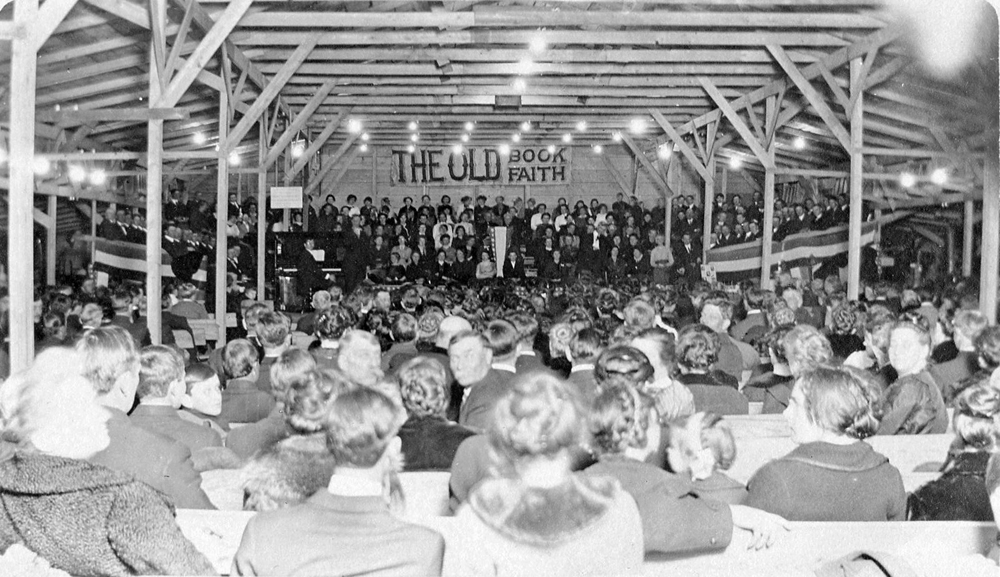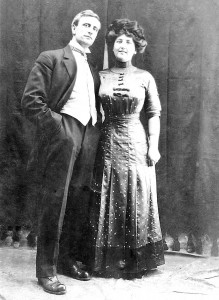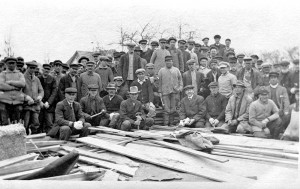When Hilton had a Tabernacle

by David Crumb
Parma-Hilton Historian
It was back in the year 1913 when Hilton Village Fathers and Religious Leaders felt their young people were drifting away from their religious training and moral responsibilities. Attendance in many of the churches was slipping. A solution was needed. An Evangelist was found and scheduled to come to town in February the following year. Five hundred dollars was collected, 120 male volunteers assembled, and with 15,000 board feet of lumber, a frame tabernacle of wood and roofing paper was constructed in several days. For six weeks, from February to April, this Tabernacle was the focal point for the people of Hilton and the surrounding rural areas of Hamlin, Clarkson and Greece.
Much of the lumber was donated and the rest was purchased. From these 15,000 board feet, a 1,000 seat building was quickly and efficiently constructed through volunteer labor made up of prominent citizens, farmers and tradesmen. They erected this temporary house of worship in several days. The location was at what today is 46 West Avenue in the village. This was two houses west of today’s Wilson Farms store. In 1914 that location was a vacant lot owned by Albert G. Smith, a wealthy Bennett Road farmer. The location was conveniently across the street from the Methodist and First Baptist churches; both sponsors of the revival. The First Baptist Church joined the Freewill Baptist Church in 1922 wherein both were then located on Lake Avenue and became known as the Lake Avenue Baptist Church.

Reverend Ernest Crabill and wife Annabel. He was a former baseball star in the early 1900s. They formed a very successful ministry in Western New York. Provided photo
The Evangelist was Reverend Ernest G. Crabill accompanied by his beautiful and talented wife Annabel, along with a music director and a business manager, all who assisted in generating the many successful programs taking place during the following six weeks. Reverend Crabill, a handsome, former star baseball player from Binghamton, known as the “Pitcher Preacher” made the rounds of Western New York towns and villages, and was even called to Maine, Pennsylvania, Ohio and other Midwestern states to deliver his gospel. He was dynamic, charismatic, and highly respected.
While Reverend and Mrs. Crabill presided at the Tabernacle, the village was awash with excitement and religious fervor. Nightly services were well attended and 642 persons made or renewed their vows to accept Christ. The village population at the time was 600. Those who attended never forgot their experience and many passed on the story to their children in later years.
It wasn’t just the local Hiltonites that attended. Men and women from Kendall, Brockport and Spencerport also came. Families even as far away as North Rose came by the Rome, Watertown and Ogdensburg Railroad (better known as “Hojack”) passenger service. It was reported that during the last days of the Tabernacle, a special train was chartered from Lyndonville with 350 people to attend a program. The group returned home the same evening.
Reverend Crabill addressed many fraternal groups; Clio Masonic Lodge; Hilton Lodge I.O.G.T.; G.A.R.; D.A.R.; I.O.O.F.; and Mother’s Club. Many evenings the Tabernacle was filled to capacity. A choir of 40 voices accompanied by an orchestra provided music and singing. “Beautiful music, stirring hymns and solos by Mr. Kemp were great features of the services.” The Hilton Record reported people running to church lest they not get a seat.
Prior to coming to Hilton, Reverend and Mrs. Crabill spent time in Wyoming County, Pennsylvania. There, 1,038 attendees were converted and $1,900 was collected for the evangelist. During the Hilton campaign, 642 were converted, but a collection of $2,020 was presented to Crabill. This was the largest he had ever received in his 13 year ministry. A telegram was sent to Reverend Crabill reporting the Tabernacle had been taken down in two hours and twenty minutes the day after his Hilton departure. “Hilton has broken nearly all the records in our work” reported Crabill.
Mrs. Crabill herself, an accomplished presenter, appeared in many biblical roles in full regalia. She re-enacted well known Bible stories much to the interest and entertainment of the attendees. Some of her roles were Mary Magdalene, Ruth and The Queen of Sheba. Old time hymns were sung from the heart, and people went away fulfilled with the Holy Spirit.

When the day came for Reverend and Mrs. Crabill to depart, a large crowd saw them off at the Hilton Depot where they caught the Morning Train for Rochester. The Tabernacle was then disassembled, the lumber sold and used for other structures. Soon after the Tabernacle was taken down, A.G. Smith built the house that is today 46 West Avenue. It is not a proven fact, but he may have purchased some of the lumber from the disassembled building and used it for this two-story colonial style home he built for himself and his second wife, Minnie.
From all reports when the Crabills left Hilton, their evangelical visit was deemed a great success. Their work and influence left an indelible mark on the community, which lingered for years. This village as well as many others had been spiritually uplifted. Parma continued as a “dry community” for many years.
Reverend Crabill continued his ministry until his death in 1936 at the age of 61. He had gone on a hunting trip in Liberty, New York and had come back to his home in Binghamton with pains in his chest. He died that evening of a heart seizure.
The information for this article comes from articles and photos in the Village of Hilton Historian’s Office. Photo reprints and additional literature is courtesy of Charles Nichols, Assistant Historian.



